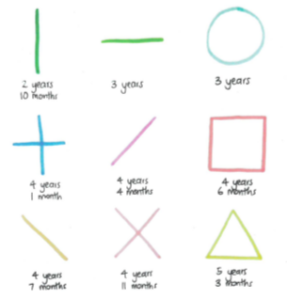What are pre-writing skills? Well, in essence they are the fundamental skills children require to develop before they can execute the functional task of writing. Some of these skills include pencil grasp, copying, drawing, colouring and writing itself. Pre-writing skills are important in child development as they assist in the ability to hold and move the pencil utilizing fluid movements of the wrist, allowing children in turn to produce legible writing.

How do we start developing these skills?
a major component of pre-writing skills is the execution of pre-writing shapes. These resemble the pencil strokes and directions that letters, numbers, and basic drawing skills are comprised of. Naturally, there is a sequential order in which these strokes are achieved in, which is matched to an age specific level. This skill can also be referred to as a child’s visual motor integration. The diagram outlines the strokes and the ages they’re suggested to be developmentally achieving them:
What are the building blocks necessary to develop the skills required for pre-writing?
They are:
- Upper Body Strength: Pre-writing skills require the strength and stability provided by our shoulders to allow for specific and controlled hand movements for good pencil control.
- Core Strength: Check out our blog on “Importance of Core Strength in Children” to learn more! https://occupationaltherapy.com.au/importance-core-strength-children/
- Hand & Finger Strength: Refers to the ability to exert force against resistance using our hands and fingers. This allows us to determine the amount of muscle power required to control various movements with the pencil.
- Midline Crossing: Crossing the midline refers to being able to instinctively move from one side of the body to the other, as though we are crossing over an imaginary line from the left to right side. This area of development is important in the establishment of a preferred hand, coordinated use of both hands and for perceptual learning.
- Hand Dominance: Consistent use of one hand for task performance, allowing for skills to become more refined.
- Pencil Grasp: The efficiency of how a pencil is held, allowing for age-appropriate pencil movements limiting fatigue and strain from occurring.
- Object Manipulation: Is the ability to move small items around in one hand without using the other to assist. There are three subareas related to in-hand manipulation, these are: translation, shift and rotation.
- Translation refers to the motor action of using just the fingertips to move a small item e.g. a coin from the palm to the fingertips.
- Shift is the motor action of moving an object using the pads of the fingertips. Shift occurs when we adjust our fingers on the pencil shaft when writing.
- Rotation occurs when rolling or turning over an object using just the fingertips. Examples include rolling a pencil in your fingertips or when turning a pencil over to erase.
- Wrist Extension: Is needed for a functional position of the hand. When the wrist is flexed (bent forwards, curving fingers) there is limited opportunity for dexterity to occur due to the positioning of tendons as they are shortened. When extended, the muscles operating the fingers can pull the tendons back easily, resulting in better control of the fingers for writing tasks.
- Visual Perception: The brain’s ability to interpret and make sense of visual images seen by the eyes, such as letters and numbers.
Pre-writing skills should be well developed before a child commences formal schooling. If you’re concerned about your child’s skills in this area, please contact us on hello@occupationaltherapy.com.au to book in a screening appointment for your child.


